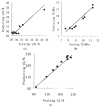Review on the Use of Artificial Intelligence to Predict Fire Performance of Construction Materials and Their Flame Retardancy
- PMID: 33672068
- PMCID: PMC7919694
- DOI: 10.3390/molecules26041022
Review on the Use of Artificial Intelligence to Predict Fire Performance of Construction Materials and Their Flame Retardancy
Abstract
The evaluation and interpretation of the behavior of construction materials under fire conditions have been complicated. Over the last few years, artificial intelligence (AI) has emerged as a reliable method to tackle this engineering problem. This review summarizes existing studies that applied AI to predict the fire performance of different construction materials (e.g., concrete, steel, timber, and composites). The prediction of the flame retardancy of some structural components such as beams, columns, slabs, and connections by utilizing AI-based models is also discussed. The end of this review offers insights on the advantages, existing challenges, and recommendations for the development of AI techniques used to evaluate the fire performance of construction materials and their flame retardancy. This review offers a comprehensive overview to researchers in the fields of fire engineering and material science, and it encourages them to explore and consider the use of AI in future research projects.
Keywords: artificial intelligence; chemical kinetics; combustion; flame retardants; machine learning; pyrolysis.
Conflict of interest statement
The authors declare no conflict of interest.
Figures












References
-
- International Organization for Standardization . ISO 5660-1: Reaction-to-Fire Tests-Heat Release, Smoke Production and Mass Loss Rate-Part 1:(Cone Calorimeter Method) International Organization for Standardization; Geneva, Switzerland: 2002.
-
- Tu J., Yeoh G.H., Liu C. Computational Fluid Dynamics: A Practical Approach. Butterworth-Heinemann; Oxford, UK: 2018.
-
- He K., Zhang X., Ren S., Sun J. Deep Residual Learning for Image Recognition; Proceedings of the IEEE Conference on Computer Vision and Pattern Recognition (CVPR); Las Vegas, NV, USA. 27–30 June 2016; pp. 770–778. - DOI
-
- Hinton G., Deng L., Yu D., Dahl G.E., Mohamed A.-R., Jaitly N., Senior A., Vanhoucke V., Nguyen P., Sainath T.N., et al. Deep Neural Networks for Acoustic Modeling in Speech Recognition: The Shared Views of Four Research Groups. IEEE Signal Process. Mag. 2012;29:82–97. doi: 10.1109/MSP.2012.2205597. - DOI
-
- Pazzani M., Billsus D. Learning and Revising User Profiles: The Identification of Interesting Web Sites. Mach. Learn. 1997;27:313–331. doi: 10.1023/a:1007369909943. - DOI
Publication types
MeSH terms
Substances
Grants and funding
LinkOut - more resources
Full Text Sources
Other Literature Sources

